Research Article - (2024) Volume 1, Issue 1
Before or After - The Big Bang Paradox
Received Date: Jun 05, 2024 / Accepted Date: Jul 01, 2024 / Published Date: Jul 11, 2024
Abstract
This article describes the hypothesis-testing experiments conducted simultaneously in time. The theoretical basis of the hypoth- esis is designed in a way that the null hypothesis and alternative hypothesis contradicts each other, while the alternative hy- pothesis cannot be theoretically reached without the null hypothesis. Modern and contemporary cosmological theories have the common source from the Big Bang theory, albeit none guarantees the absolute correctness of it. The null hypothesis is falsified in the experiments, without developing further cosmological theory thereon. It is an intermediate corroboration to the Confor- mal Cyclic Cosmology, but does not prove it. The methods adopted in the experiments adapted special relativity and quantum physics to observational instrumentation and data science. The experiments conclude the logic in Big Bang falsification, and the cosmological possibility in Tycho particles from the evidence of Hawking points.
Introduction
Demise of individual consciousness in the cosmic environment founded the conceptual basis of time in human civilizations. The unidirectional flow of time is the anchoring of human consciousness to the phase shifts of matter, in which a human brain experience as well [1-3]. Grand Unification Theories (GUT), in this context, seek to adhere a continuum of consciousness in the physical cosmos. While physical cosmologies, with the Big Bang Theory (BB) included, favor a GUT for their theoretical foundations to each other, mainstream alternative cosmologies tackle with the perspective of time, including String Theory (ST), Conformal Cyclic Cosmology (CCC), and others such as Alfven Klein cosmology (see [4]). Most of the alternative cosmological theories attempts to transcend the Hubble scheme after the electroweak astronomical applications, but only the CCC dissected the interlinkage of BB and GUT with aeons [5,6].
Almost all cosmological theories are founded upon the fundamental physical presumptions of the BB, and hardly any progresses have been made since. The CCC is a mathematical compromise from the pre-BB insights of Penrose from the Plank scale, and “Before the Big Bang” was already implicative to the falsification of the BB [7,8]. However, no definitive evidence on a concrete physical basis has been present in its empirical falsification. The physical basis of two types of the celestial objects has the capacity for the discretion of empiricism, i.e., black hole (BH) and white hole (WH). For the purpose of the discussions followed, the theoretical basis of the black hole and white hole thermonuclear binding is considered as the alternative hypothesis H1 , and the BB is considered as the null hypothesis H0 – corresponding to the theoretical basis the original theory built upon [9].
It is physically determined that H1 or H0 cannot both be valid. Contradiction is implied in the theory that either H1 or H0 is true, Type I error or Type II error is certain, respectively. Furthermore, if H1 were true, the physical nature of singularity ought to be explainable [10]. Two experiments were conducted simultaneously for qualitative test and statistical test. The former experiment accessed the singularity from the black hole perspective, and the latter, experimenting on observational cosmology, accessed the singularity from the white hole perspective. The first portion of the article outlines the theoretical physics basis of H1 . The theoretical physics basis is not in contradiction with the cosmologically fundamental insights of Penrose from the CCC [8]. It answers the negative energy question in the pre-BB theory [7,8]. What it challenges is the fundamental notion on the concept of time that is mundanely accustomed and globally coordinated. It is with this regard, the article only purposes for a description account on the hypothesis testing, and the alternative cosmological theory with consciousness taken into consideration will be formed in later writings.
Subjective bias in the research design was also taken into consideration. The research design is positivist to H1 with the motivation behind the empirical research, and postpositivist philosophy deconstructs the a priori epistemology in the BB, i.e., H0 . The minimization of subjective bias in the research design is philosophically homogenous to the development of CCC, while the heterogeneity lies with the motivational background [11]. As the empiricism motivation was transdisciplinary to multilateralism, international law, and international relations, it is replaced with another research question in the article: is there something more fundamental in astronomy and cosmology than space, time, and matter? From the continuity of the theoretical inquiries, nuclear force can be the plausible answer. When force is considered the fundamental quality, the equivalence of matter and energy renders quantitative meanings to light and light sensors with the distributions in the quantities of space and time [12]. The fundamentalism resolves gravitational constant with Tycho particle in time distribution, and dissects the concept of time from life forms and human evolution, as implied by the name Aeon in geological time scale [1,6].
Methods
Background
The elasticity of space and time in wavelength shifts does not resolve information paradox, however, H1 does not have the paradox to BH information [7]. Since the information of BHs are theoretically emitted from WHs, the recombination of information from holographic BHs in the qualitative experiment set off from H0 without presuming Type I error [13]. It was inductive from H0 behind the space-based telescope missions’ data collection, which topologically recorded cosmic rays (CR) to the geological distributions from the NGC 3034 local BH [13,14]. The linearity of time parameters from the multi-mission observation data from the 2020 NASA Data Challenge on NGC 3034 were, therefore, dismantled [15]. The exact physical location of the BH and plausible WH was not known or necessary to be known for the experiment, and the only known was that, out of the multispectral data, the thermonuclear causal inference and evidence can be drawn [16].
The time-distribution observations and processing conversions were performed with SAOImageDS9 MacOS’s ZScale function, which is not incorporated in JS9-4L online. Information paradox was conceived before computer graphics applications, and the technical dilemma between information paradox and entropy is resolved by the recombination of decayed information as an anti entropic approach to the data-science-enabled technique with light information [17,18]. The qualitative experiment saw the multispectral initial states as an end state from orbital detection in each angular momentum [19]. This does not violate celestial causality from detection methods for the premises that celestial objects are relatively constant in thermonuclear equilibrium, corroborated by the NGC 3034 Neo WISE data through the Infrared Science Archive (IRSA) queries for internal validity and in-experiment interrater reliability [15].
In minimizing the subjective bias with the theoretical presumptions, internal validity was designed with an interrater reliability design between the two experiments. If BH and WH can be observed with the Micro Observatory, the qualitative design would be internally valid regardless of the theoretical presumptions. If only BH can be observed, there is possibility for Type II error; if only WH can be observed, no explanatory paradigm exists; and if neither are observed, the qualitative design can be invalid. A further evaluative research question exists on the methodological level, that whether the phenomenon of BHs is only an instrumental instead of astronomical phenomenon. The evaluative question can only be furthered by a descriptive paradigm in celestial phenomenon, and an explanatory paradigm for cosmology. The explorative questions were included and preliminarily answered in the original theory without the falsification of the BB. Empirical evidence of the fifth cosmic force begotten from the qualitative experiment furthered the research question into the exploratory and generative ones in cosmology and astronomy [20]. The latter questions further developed into consciousness studies and neuropsychological studies that are beyond the scope of the article [1,2].
The main limitation of the research is that no predictability was preconceived. In the qualitative design, the data were not collected by the researcher but only operated upon with the frontend of the software; in the quantitative design, the observations were randomized for the interrater purposes. The observation decisions were made intuitively and spontaneously during the qualitative research process and afterwards. The only predesigned elements are the sun and moon observations with unexpected results [21]. The moon and sun observations were predesigned for the researcher’s sense of geological time during the preoccupied observational processes. The observational data processing and analyses in the quantitative experiment reproduced the multispectral methods developed in the qualitative experiment [9].
Space, Time, and Matter in Cosmology
WHs negate the concept of time being associated with space. Spacetime continuum is accustomed to ascribe and describe the movement of matter. Cosmic evolution, either in symmetric or asymmetric presumptions, followed suit with spacetime continuation with the BB. Unidirectionality of time exists with conscious experience of life forms, but only bidirectional when it comes to inanimate objects [22]. The differentiation of organic and inorganic chemistry is, therefore, considered anthropological. WHs being the time reversal of BHs comes to the edge of continuous presumptions of space and time in its four dimensional descriptions, vertex spaces supplement WH studies in the BB framework, carving into its donut-shaped presumptions [19,21].
WHs do not necessarily negate space, but the presumptions of space in cosmology. With the linearity of cosmic time, it was proposed that WHs created small bangs to correlate the initial thermonuclear conditions in the BB framework [7,23]. However, the BB itself avoided the question of space in cosmology. The expansion and contraction in the BB do not represent the expansion or contraction of space. Since the whole of space is simultaneous in time, current theories only look for the corrective solution from the event itself or to replicate the event across space, making it pluralistic inherently or externally to compensate for the bidirectionality of time concept. The dimensionality of time is therefore proposed, that the concept of time is relative. Time cannot be perceived or measured without the change or movement of matter, and the conceptual development of time is closely associated with the solar celestial movements [1]. Statistical values of time in relation to a singularistic space is then justified, or justifiable if further proofs are needed, by the proposition. Nuclear forces in its nuclear chemistry and nuclear physics undertones, thereby, are the microscopic singularities to the macroscopic celestial objects in the spacetime coordinates of zeros, or Hamiltonian zeros in the context of quantum physics [17].
Qualitative Experiment
Two elements from the NGC 3034 data histograms in angular cycles respectively in solar and elliptical earth orbits corroborated with H1 :
1. crystallization on the SPITZER cryogenic plate, indicating to below absolute zero CR source [24];
2. antimatter distribution in Chandra X-ray along with high energy emissions around the BH event horizon, indicating to the co-existence of extremely high and low thermal equilibrium in the source(s) [13].
However, constructing the multi-wavelength data to the local source(s) cannot follow suit with geological time parameters nor the mere spatial distributions of the instrumentation to the distances. GALEX’s ultraviolet (UV) photometry using sequential counts to bridge the gaps between far-UV (FUV) and near-UV (NUV) bands inspired the multispectral recombination technical validity, in finding pulsation points to align the multi-mission space telescope data [25]. Figure 1 is an example of direct addition of multi-wavelength data from the earth’s vantage point of traditional observation presumptions not accounting for super determinism with orbital solutions on space-based telescopes [15,19].
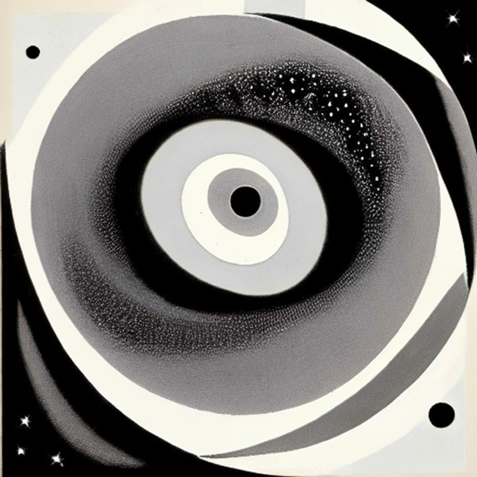
Figure 1: The Direct Multi-Wavelength Histogram Layer Addition Resemblance Without Correction by Super Determinism
Artificial intelligence image generated from images.ai, with the depiction of “a white hole and a black hole emitting dark matter by the fifth cosmic force”.
WH physics are summarized phenomenologically that WH surface is caused by its nuclear repulsive force surpassing its gravitational force, which is incompletely evidenced by NGC 3034’s neutron asymmetry in proton decay momentum [15,26]. The pressure dependent elasticity of nuclear attractive force can function with the source-dependent nuclear caloric curve for WH crystallization. The sub-Fermi theorization is best characterized by the elasticity of non-Newtonian liquids. The experiment of McIntosh, Bonasera evidenced the quasi-projectile higher temperature in neutron poor sources, i.e., traces in the nuclear caloric curve nuclear attractive force stronger than the strong interaction [27]. Alberti and Chavanis further studied into the gravitational catastrophe (thermal runaway), indicating that with enough pressure for spatial confinement, the maximum energy of caloric curve underlies black body radiation [28].
Black body radiation in the BB framework is often interpreted as BH evaporation. The asymptotic momentum in general relativistic effects between WH and BH was depicted as gravitational collapse with the heat-induced value thresholds of the Coulomb force, but the suppression of particles with higher spin (e.g. gravitons) in Schwarzschild BHs indicates otherwise [28,29]. Fermi surface wrapping provides the physical basis for counteracting Coulomb repulsion in proton-rich concentrates Ishiguro, with reduced perturbation in metallic systems [9,30-32]. Therefore, black body radiation is evidence for WH nuclear dynamics instead of BH evaporation.
Vector anisotropy was operated upon the data topology after the alignments. The dynamic observational alignments were smoother for the Chandra X-ray and SPITZER pieces for continuity, and the multispectral alignment took some extra efforts. The virtual interferometric process with multispectral data initiated the superdeterministic quantum process from the BH event horizon and ring singularity represented by SPITZER data in the local universe. The main alignment and interferometric efforts were on the local universe’s possible locality of the ring singularity, aided by the multiple-slits noticed in the multi-wavelength data [9]. The alignment sampling and the multiple-slits greatly reduced the time and length scales involved in the CR source back-tracing in the data recombination, which could have contributed to the collapsing perceptions in BH physics [33]. Angular velocity induced electromagnetism could have caused the multiple-slits along with the nucleon ripples, and the empirical nucleon topologically captured in data enabled the multispectral data recombination method supplementary to quantum field theory (QFT) [14]. The technique was inspired by the film production technique in The Matrix’s bullet time presentation and production. Analogous to the bullets, the particle distribution in time in QFT is statistically the wave function recorded in its time distribution. With the spectral data in black and white, the local BH and WH on NGC 3034 was successfully recovered on JS9-4L online in an angular-momenta reversed visual presentation [14].
The compression on WH crystallization indicates to the fifth cosmic force. The early descriptions of WHs have been located in Rasio, Shapiro as ”relativistic collision less star clusters” with the energy variable x [34]:

Its redshift function plot Zc with fractional binding energy corressponds to the ground state effective mass tendency in excitation energy Shetty, and the maximum redshift Zc → ∞ was theorized to reach stability Ratio [34,35]. Since the hot and cold double spiral in caloric curve depends on the isothermal context, their convergence in high particle number in the gas parameter
ν = (GNm)/(Rc2) can be re-conceptualized in terms of energy: [28].

Its stable state does not necessarily need to take gas forms, and the parameter’s relations to Newtonian gravity with regard to the WH in question becomes:

The inverse correlation between particle number and v_max becomes the prerequisite of WH formation Alberti [28]. Inductively, the fifth cosmic force needs to be in place for the asymptotic momentum of protons for the internal centrifugal sorting for the Fermi surface to form, with the baryon asymmetry in proton decay [36,37]. From the nuclear caloric curve, it can be inferred that the physical properties of WHs are possible, and its parameters in the SI definition of time may create negative numerical values. The matter occupation of space by WHs does not conflict with its gravitation and nuclear repulsive properties. The existence of WHs imply that time is relative in the SI definition of time. WH gravitation in the nuclear caloric curve falsifies the BB both on hot and cold BB. The cosmic forces determine time dilation and matter occupation of space, which is the fundamental basis of the BB. The hot and cold spirals of the nuclear caloric curve may be key to the explanatory paradigms of genetic life formation and sustainment, both on the inherent and environmental factors cosmically. Higher order of the fifth cosmic force may provide further insights into the dimensionality of cosmology, and exotic matter forms. Dark matter and dark energy are not observed nor detected possibly by the locking effects of WHs. Therein lies the threshold of our current cosmological knowledge.
Quantitative Experiment
Null geodesics is characteristically implied in the BB and general relativity (GR). Consequently, the null infinity of time in the past ought not to be able to reconstruct events successfully. The material field reconstruction in the qualitative experiment in Figure 2 seems to have adhered to the null geodesics with holographic principle.
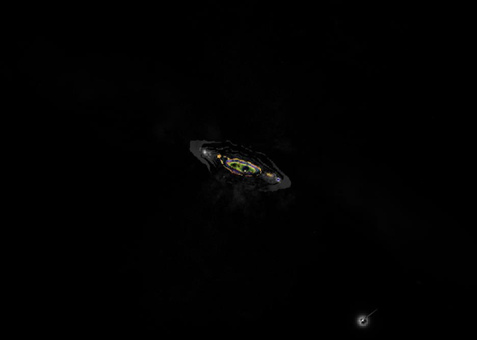
Figure 2: The Material Field Multispectral Recombination on NGC 3034 in the Qualitative Experiment
Data obtained from the NASA Data Challenge archive with the URL: https://waps.cfa.harvard.edu/eduportal/js9/ softwareChallenge_Archive.php [38].
Despite of my own theoretical background, Bonifacio, Hinterbichler applied complex Ginzburg-Landau equation in de Sitter space, with the |A| element in the place of Dirac equation, and founded the possibilities for particle physics to be applied in the geometric infinities of singularities [39]. The numerical notice shaped a data graphical foundation on possible antimatter electromagnetism with relation to electromagnetism in those observation data [13]. The particle re-combinations from the multi-spectral asymptotic decay back-tracing started with the Zscale from the Euclidean World Coordinate System [18,40].
Durdevich described “the formalism of quantum geometry” as “a symbiosis of global methods from classical differential geometry, with non-commutative algebras and functional analysis” [41]. The inconsistency problems in physics and mathematical physics in Einstein-Rosen Bridge problem that first appeared in Einstein were regarded as a nuclear chemistry problem with an alternative mathematical thinking in the experiments [42]. Borrowed from the concept of negative space in visual art, the question of triangles with two sides equal to 4 cm and 5 cm respectively, the third side can either be −3 cm or 3 cm in GR with matter presence. Numerical algebraic geometry hence can be effective in solving Riemann surfaces that underlie the mathematical and topological construct of Cauchy surface. The isomorphism from classical or semi-classical gravity in instrumentation, to the operationally correct engineering space in Riemann zeta functional topology in raw data, and to the base-system-bounded analyses of vector field-extended space and time-lengths, is then connected with the Goldbach Conjecture [15]. The products in the quantum baseline between the space-based telescopes and the ground-based Micro Observatory shaped the foundation of the quantitative experiment, and the observational data can be accessed on Zenodo with the DOI: 10.5281/zenodo.7187571 [43].
In BH studies, Hawking observed the phenomenon inconsistent to the classical descriptions of BH, with relation to the Baryonic entropy [44]. It was believed that either new theories of quantum gravity needed to be in place, or the naked singularity of negative mass were behind the gravitational collapse. Nomura and Yoshida stated that, “typical examples of singularities ... involve the divergence of local curvature invariants”, and Hossenfelder communicated the meta-materials’ change to space and time perceptions in observational cosmology, implying that the perception of negative space is made possible without needing to change the concept of time in current civilization settings [45,46]. The local curvature invariants are naturally refracted to a negative space with “negative refractive index” that brings the far field to near field detection and observation [46]. The connotation is then that the near-range gravitation and far-range special relativity (SR) are convertible.
• Three Questions then Arise From the Seemingly Absurd Connotation:
1. is the convertibility between SR and gravity an amplification effect?
2. is the convertibility only a conscious perception, or does it exist in physical realities?
3. is there any quantifiable feature of gravity in SR?
The null-geodesics of scalar fields on Cauchy surfaces surround a BH and singularity. Einstein approximated null-geodesics with “a second system of co’ordinates K'” “in a homogeneous gravitational field (acceleration of gravity γ)” with the gravitation of energy in two material systems S_1 and S_2, with observed phenomenon of energy E “emitted from S_2 towards S_1” [47]. With the gravitational deduction from the multi-mission survey, the multi-spectral matter fields revealed the existence of the fifth cosmic force between the BH and the WH of the Kerr-Newman supermassive compact (KNSC) on NGC 3034 seen in Figure 2 [9,11]. From the neutron degeneration momentum of natural decay observed from the multi-wavelength surveys, the fifth cosmic force was considered to be less likely observed from the BH portal, differentiated from the surface plasma recombination of the analyzed observational evidence in Figure 3 by superconductivity, which has always been deciphered as a quantum physical phenomenon without cosmological implications. Therefore, the observation of an isolated WH in the quantitative experiment would exclude the phenomenon being “simply quantum physical”.
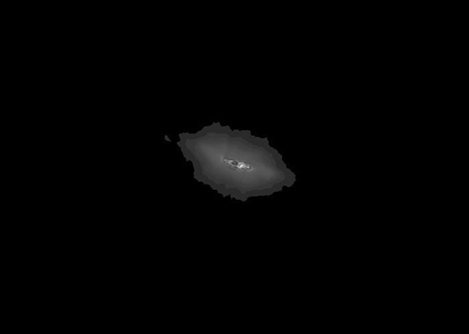
Figure 3: The Monochrome Plasma Recombination on the BH and WH on NGC 3034 from the Qualitative Experiment [9]
The space-based telescopes collected submerged CR via cryogenic deuterium, and transmitted the intensity distribution data to the cryogenic deuterium or tritium as the quantum baseline [18]. The information designs changed the fundamental paradigmatic basis of electronic engineering during the conception of relativity theories [42]. Nonetheless, the baseline of quantum criticality in superconductivity is constant regardless of the mission design specifications in wavelengths and spatial distribution in deployments. Categorically, the qualitative research adopted the methods of multiple-slit recombination, numerical analysis, observational cosmology, base system analysis, thermal and radiation analysis, thermonuclear astrophysics, thermonuclear analysis, instrumentation analysis, signal analysis, SR, Lorentz transformation, analytical geometry, and plasma analysis. The multiple-slit recombination, numerical analysis, and thermal and radiation analysis were performed to analyze the cosmic forces. The numerical analysis on the circumnuclear ring of gamma decay event horizon was performed with SAO Image DS9 MacOS [48,49]. From the numerical values that can be reproduced with the data and software publicly available, the low energy piece mainly composed of square roots of integra table numbers, and mid energy composed of similar infinite continued fractions. The high energy piece contains both prime numbers or numbers with prime elements, and whole numbers with or without half-spin. It can be further seen that the half-spin and infinite continued fractions are inconsistent with each other. Further technical details and dimensional analysis can be given for the reproductivity of this figure.
Without changing the space-time geometry, the quantitative experiment used the negative cosmological constant with the Penrose-Hawking singularity for the first system of co-ordinates K according to the multi-spectral material fields results, in search of WH with the earth-based ground-distributed telescope observations [21]. The choice of negative cosmological constant was contributed by the antimatter distribution in the Chandra X-ray gamma decay data histogram on NGC 3034, in relation to the antimatter saturated plasma recombined in Figure 3, which was predominantly considered as quantum foam [13]. It can be seen that the gravitational decay pattern is associated with the luminescent surface of the fifth cosmic force and outer rings of the KNSC, with relation to the neutron degeneration from the WH portal, in comparison to the BH portal visible in Figure 3. From the summary of Bartelmann, Pachankis's approach is most similar to Friedmann’s approach in ω asymmetry [21,50]. The convergence of GR was predicted in the Friedmann model with K=0, implying that both the BH solution and WH solution in GR reach the threshold at the convergence where Forrington theorized as Magnetosphere Eternally Collapsing Object (MECO) [50,51]. The theorization is consistent with the later observation seen in Figure 4 and the phenomenological causality to be analyzed.
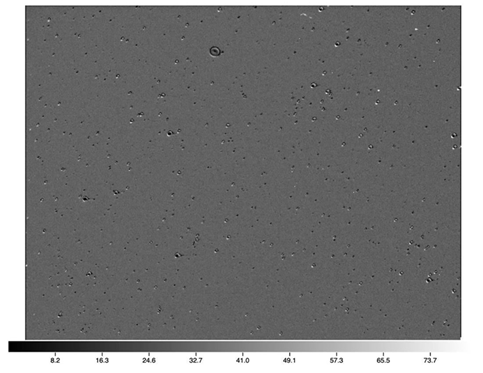
Figure 4: The Dark Energy Geodesics of the MECO on Ring Nebula M57 Observed on Jun 12, 2022 with Harvard-Smithsonian Micro Observatory
The observations followed a 5-body problem rationale with regard to the earth-based observatory and BH-WH two-body. How to batch-process the positive results' historic data for future predictive references is an on-going project. If the distance of each body to the other four is described in S, the celestial motions do not always agree to a single and simple plane, especially considering gravitational waves in observational duration dt. The (5/2)=20 elementary dimensional vectors can produce (20/3)=6840 possible three-dimensional planes. Making the observational standpoint of self-rotating earth as the intermediate point simplifies the 5-body problem to two planes with a solar three-body to the two- body system by an intermediate sum mass as to earth. As the technical details can be further refined with quantum computing developments, the most problematic will be the scientific consensus between cosmological / Plank scales and operational parameters.
The cosmological evidence from the quantitative experiment is mainly technical. By the simultaneity of happening, the past infinity of the BB ought not to be observable, and the past null geodesics event(s) ought to have been contained by the BB itself [52]. Furthermore, if the past null infinity held, the "before" assertion on the BB ought to have been false; otherwise, if "before" is true, past null geodesics must be false. The positive results themselves in WH observation broke the past null infinity [52]. The video of WH time dilation can be viewed at https://doi.org/10.5281/ zenodo.6504931, with the strong force baseline in the Small Magellanic Cloud observation in Higgs boson representation. The Small Magellanic Cloud was illuminated by the weak force resonance in the "exposure" process. With the conformal region experience with NGC 3034 KNSC, the BH seed and WH seeds collision with exotic metal insulator formation signature was observed on the M20 Trifid Nebula seen in Figure 5 [9]. The high- frequency Doppler Shift in the analytic procedural processing can be viewed in the video at https://doi.org/10.5281/zenodo.6426887. The lining of the fifth cosmic force was configured to the BH in the shadow of the WH, with high background noise contributed by the antimatter saturated plasma with the explosive collision momentum, exhibited in Figure 6.
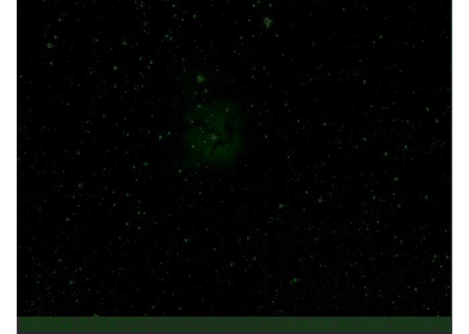
Figure 5: The Warm Dark Matter Representation of the Exotic Metal Insulator on the M20 Trifid Nebula
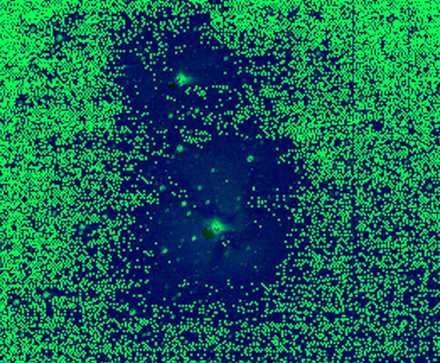
Figure 6: The Shadow of the BH Illuminated by the WH and Fifth Cosmic Force on M20 Trifid Nebula
Even though the extreme curvature on the moon observation was not expected, the quantitative experiment’s falsification on the past null infinity and null geodesics has already been certain. The observational cosmology series indicated that virtual particles are not virtual, and the pseudo-scalars are actual antimatter from the BH and WH seen in Figure 3 [13,21]. “Considering the time development of a Cauchy hypersurface C3 representing an initial matter distribution”, as Penrose suggested and applied to the BH, furthering the second coordinate system K' from Einstein, ”infinity can be treated as though it were simply an ordinary three dimensional boundary to a ’finite’ four-dimensional conformal region” [10,47]. Albeit with the thermonuclear binding between a BH and a WH, the matter of precision in the observations were full of uncertainties by radiative divergence of light information in CR in distances. What was certain is that only a higher dimensional observation from the WH can receive the information from the f ifth cosmic force.
The observational cosmology, especially the moon curvature, reaffirmed the validity of the Kalekin and collaboration designs & scientific output [53]. From the observational cosmology perspective, microgravity in low energy may have higher nuclear astrochemical potential. The 50 − 100 GeV and possibly below may contain higher proportions of WH neutrinos than the BH neutrinos [54]. This is consistent in the proportional decrease patterns with regard to W [a]symmetry [15]. The curvature from the data suggests the inverse thermal flux sensitivities can be further adjusted not in engineering terms of cooling effects, but the angular search detection and sensitivity adjustment for low temperature neutrino fluxes exemplified around the ANTARES sensitivity line for point-like sources [44,53]. This may further exclude the amount of double and neutrinos for further precision.
Results
The Fifth Cosmic Force
The fifth cosmic force on NGC 3034 was processed after the completion of the quantitative experiment, resulting from a gravitational recombination attempt. Albeit no tychons have been seen in the result, flavored free quarks have been seen in the final composition in the asymptotic decay layers [26,33]. Positive reading on the negative result may suggest the acceleration of time scale for the quantum recombination to catch up may have exceeded the orbital frequencies producing the oscillation momentum, which is compatible with super determinism with relation to the Trifid Nebula M20 result in the quantitative experiment [19,21,33]. Another untechnical explanation with the antimatter distribution in Chandra X-ray data on the local momentum seen in Figure 2 may be that exotic matter forms in BH and WH decay into currently known matter forms, but are not necessarily detectable by current sensor technologies [26,55]. This interpretation also does not contradict with super determinism and directs further explorations into quantum empiricism. The two explanations do not exclude each other and can contribute equally to the current results where the radiative tails of the trajectories have not captured the dependent future input [20].
Invariant Hawking points appeared with further radiation analysis on the multispectral data. The appearance of Hawking points was mainly contributed by the X-ray data and not dissimilar to the kinematic processing [9,13]. However, the radiative diffusion in the outer boundaries of the event horizon corresponded with the instrumentation rationale illustrated in Figure 7 behind the qualitative experiment, and with the phenomenological Hawking radiations [56]. Further quantitative research into the systematic stability of BH and WH thermonuclear binding may be needed to settle the BH evaporation debates, but the BH information paradox is resolved with the preliminary qualitative results [57]. The results correspond with cosmic censorship hypothesis that should naked singularity exist, it exists beyond the current BB paradigm and the definition of time thereof [8,20]. The results offer the possibility that naked singularity is the fifth cosmic force clouded by the BB presumptions and null geodesics precarity.
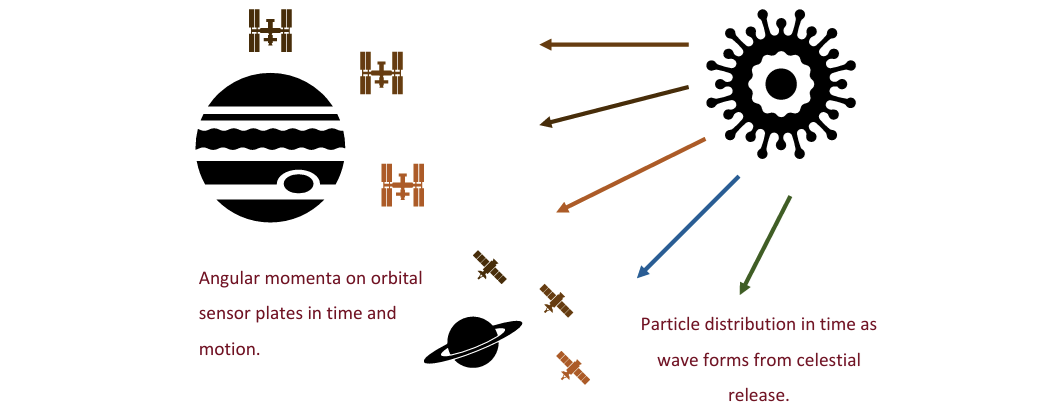
Figure 7: Conceptual rendering on the Observational Distribution in super determinism with moving detection plates on CR [18,19]
White Hole Seed
The result from Figure 8 extended the BH seed results and light seed prediction of Ricarte and Natarajan’s to the collision momentum of BH seed and WH seed on the trajectories of ring singularity by the weak force analysis [58]. It suggests that the asymptotic decay in Figure 2 is contained and regulated by the collision momentum with the quadruple matter and antimatter electromagnetism [10,13]. The collision momentum effectively explains the MECO phenomenon with the engineering limitations to the thermonuclear explosive kinematics. Since the engineering impossibilities of capturing further gravitational details from the asymptotic decay momentum, with the quantum baseline set previously, the observational cosmology shifted to Micro Observatory observations, with a backward direction to the earth’s electromagnetism.
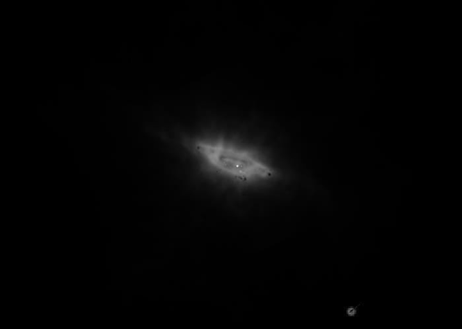
Figure 8: The BH Seed and WH seed Collision Momentum on Ring Singularity on NGC 3034 KNSC
The time parameters have been organized from Universal Time Coordinated to global, local, and exposure properties, and the data analysis rationale followed a signal-digitalization paradigm of mathematical thinking in computational bases with spectral coordinates [59]. With the involvement of negative space and the inverse direction of earth’s electromagnetism, the triggering mechanism on time coordinates with relation to the celestial coordinates, was hence leveraged against the singularity with relative motions, which also underlay the NGC 3034 data analysis processing from Zscale [40,60].
Discussions
Even though no definitive evidence has been produced from the experiments on the existence or nonexistence of Tycho particles, the antimatter involvement, take positrons for example, in the collision and oscillation momenta should provide further insights. Further research on Tycho particles is not only relevant to particle physics, but also to cosmology with the nature in the fifth cosmic force phenomenon.
The CCC is neither supported nor proven in the experiments, but GR is implied to be flawed. The propositions of the CCC may have taken GR into consideration, and therefore, built upon the BB instead of falsifying it. It implies that CCC’s empiricism is pragmatic while not cosmologically empiricist. This renders ST’s complementary role in the cosmological constructivism. The experiment findings furthered the causal inference on the formation of Hawking points. The thermonuclear astrophysical and astrochemical dynamics in the fifth cosmic force are multidimensional. It is an interlinkage between particle physics and physical cosmology. Its non-imaging’s causal inference cannot be determined without antimatter material sensors.
Appendices and Nomenclature
The experiments claim the naming of light seed as white hole seed.
Conclusion
The observational cosmology experiment was a confirmation on the systemic change on the Hilbert space with the robotic system. The logical relations to the observational cosmology are summarized as:
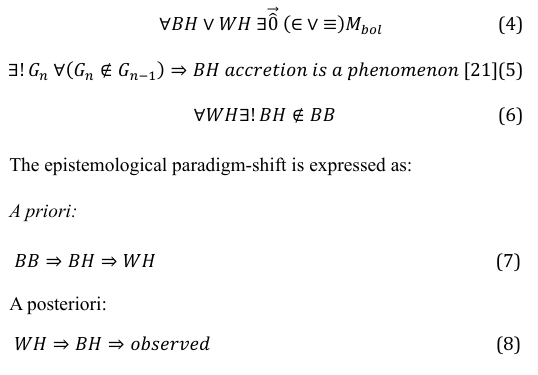
With quantum tunneling,

quantum BHs are dependent on WHs. Since the BB is not dependent on quantum,

and by pre-BB theory [8] BH is supposed to be true; the physical existence of black hole in the quantum system is signified by active galactic nuclei (AGN) [15]:

and quantum BHs prove physical BHs. The BB is singular thus WH was supposed to be pre-BB (Eq. 10). With the fifth cosmic force that is not the AGN, the original design with proof by contradiction corroborated with the conformal boundary of NGC 3034 seen in Figure 9 [21].
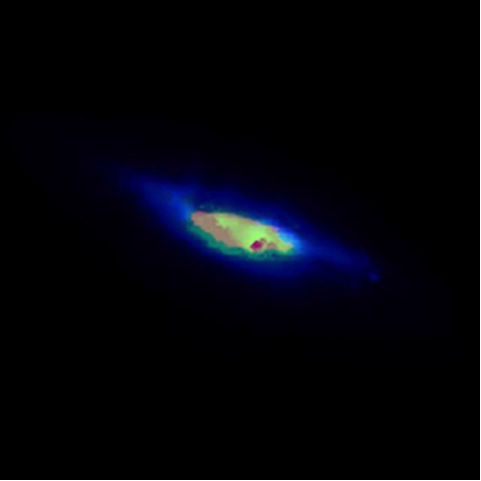
Figure 9: The BH seed and WH seed Collision Momentum on NGC 3034 on the Conformal Boundary of Ring Singularity
With the detail of neutron degeneration from the BH seen in Figure 3, the causation of the BH & WH thermonuclear binding is expressed as:

The indirect evidence in Figure 2 is then completed by the direct evidence from the WH observations with the fifth cosmic force seen in Figure 6, that the oscillation of the fifth cosmic force is the source of BH & WH phenomenon being observed. The high noise in the direct evidence implies that particle-wave duality comes from the incompleteness of WH material states with the detection materials. A complete report on the results can be accessed on Internet Archive with the URL: https://archive.org/ details/BBfalsification. By the diminishing visibility of the WH, the later M87 experiment is excluded, which still may have further values in more detailed particle analysis with the quantum deflation effects. The observational data were mostly anticipated results, except for the slight surprise from the moon observation with the videos that can be viewed at https://doi.org/10.5281/zenodo.6504931.
The falsification of the BB implies that antimatter and dark matter distribution in the universe can be largely underestimated, and the formation of the solar wind is contributed by the fifth cosmic force with variations in the BH and WH, which comes close to the resonance effects. The dictum is formed that:

With AGN→WH⇒BH, exotic metal-insulator formation serves as the thermal resistor for BH and WH compact regions, and is key to the thermonuclear stability of the structure. ∃(Fusion Plasma∧Fission Plasma) in cold fusion and hot fission regulated by antimatter, and the ring singularity adjusts thermonuclear instability with asymmetric degradation. With the existing observational paradigm, the preservation on the fifth postulate of Euclidean geometry applied in the cosmological and astronomical sciences [21] is:

The presentation for the conclusions can be accessed on Internet Archive with the URL: https://archive.org/details/WHpresentation.
Acknowledgments
I thank the University of Arizona’s Astronomy Arcade and distinguished professor Chris D. Impey for introducing me to the instrumentations, hosting Q&As for continuous academic interactions, and the encouragements. I thank NASA for making the data and observatory publicly available, which made the research happen.
References
1. Pachankis, Y. (2022). Is time a physical unit?. Science set journal of physics, 1(1), 1-4.
2. Pachankis, Y. (2023). Is there a Bioinformatic entropy in Cosmoconsciousness?—Proposal for experimental trials. Journal of Physical Chemistry B, 13, 350.
3. Hameroff, S., & Penrose, R. (2014). Consciousness in the universe: A review of the ‘Orch OR’theory. Physics of life reviews, 11(1), 39-78.
4. Alfvén, H. (1987). Plasma universe. Physica Scripta, 1987(T18), 20.
5. Hubble, E. P. (1979). Extra-galactic nebulae. In A Source Book in Astronomy and Astrophysics, 1900–1975 (pp. 716 724). Harvard University Press.
6. Gurzadyan, V.G., Penrose, R. (2016). CCC and the Fermi paradox. Eur. Phys. J. Plus 131, 11.
7. Penrose, R. (2006, June). Before the big bang: an outrageous new perspective and its implications for particle physics. In Proceedings of EPAC (pp. 2759-2763).
8. Penrose, R. (2018). The big bang and its dark-matter content: Whence, whither, and wherefore. Foundations of Physics, 48, 1177-1190.
9. Pachankis, Y. (2021). Research on the Kerr-Newman Black Hole in M82 Confirms Black Hole and White Hole Juxtapose (Thermonuclear Binding). Academia Letters, Article, 3199.
10. Penrose, R. (1965). Gravitational collapse and space-time singularities. Physical Review Letters, 14(3), 57. 1
1. Pachankis, Y. (2022). Physical Signals and their Thermonuclear Astrochemical Potentials: A Review on Outer Space Technologies. International Journal of Innovative Science and Research Technology, 7(5), 669-674.
12. Impey CD. February 1, 2023 Astronomy Q&A Session with Prof. Chris Impey. YouTube; 2023.
13. Pachankis, Y. I. (2022). A multi-wavelength data analysis with multi-mission space telescopes.
14. Pachankis, Y. (2022). Data-driven insights to cosmology in the dark universe. Journal of Plasma Chemistry and Plasma Processing Research, 3, 43-50.
15. Pachankis, Y. (2022). The lenses of quantum physics on earth to the cosmos: From the humanities to the apocalyptic inevitability.
16. Bohm, D., & Hiley, B. J. (1981). Nonlocality in quantum theory understood in terms of Einstein's nonlinear field approach. Foundations of Physics, 11(7), 529-546.
17. Pachankis, Y. (2022). Mass Surveillance, Behavioural Control, and Psychological Coercion the Moral Ethical Risks in Commercial Devices. Computer Science & Information Technology, 12(13), 151-168.
18. Pachankis, Y. (2022). Technical analysis on the cyber organizational criminology of dictatorial military conducts experience from human trafficking and coercions by military cyber aggressions. International Journal of Security, Privacy and Trust Management, 11(3), 1-19.
19. Hossenfelder, S., & Palmer, T. (2020). Rethinking superdeterminism. Frontiers in Physics, 8, 139.
20. Pachankis, Y. I. (2022). Some Concepts of Space, Time, and Lengths in Simplified Chinese*: An Analytical Linguistics Approach.
21. Pachankis, Y. (2022). White hole observation: An experimental result. International Journal of Innovative Science and Research Technology, 7(2), 779-790. 22.
22. Hall ET. Beyond Culture: Anchor Books; 1976. ISBN: 978-0385124744.
23. Retter, A., & Heller, S. (2012). The revival of white holes as Small Bangs. New Astronomy, 17(2), 73-75.
24. Bardeen, J. M., Carter, B., & Hawking, S. W. (1973). The four laws of black hole mechanics. Communications in mathematical physics, 31, 161-170.
25. Morrissey, P., Conrow, T., Barlow, T. A., Small, T., Seibert, M., Wyder, T. K., ... & Sukyoung, K. Y. (2007). The calibration and data products of GALEX. The Astrophysical Journal Supplement Series, 173(2), 682.
26. Pachankis, Y. (2022). Neutron number asymmetry in proton decay momentum. J of Agri Earth & Environmen-tal Sciences, 1 (1), 01, 9.
27. McIntosh, A. B., Bonasera, A., Cammarata, P., Hagel, K., Heilborn, L., Kohley, Z., ... & Yennello, S. J. (2013, March). Asymmetry dependence of the nuclear caloric curve. In Journal of Physics: Conference Series (Vol. 420, No. 1, p. 012085). IOP Publishing.
28. Alberti, G., & Chavanis, P. H. (2020). Caloric curves of classical self-gravitating systems in general relativity. Physical Review E, 101(5), 052105.
29. Dong, R., Kinney, W. H., & Stojkovic, D. (2016). Gravitational wave production by Hawking radiation from rotating primordial black holes. Journal of Cosmology and Astroparticle Physics, 2016(10), 034.
30. Ishiguro T. (2005). Crystalline Organic Metals. Encyclopedia of Condensed Matter Physics. p. 336-43.
31. Saslow, W. M. (2002). Chapter 2-Coulomb's Law for Static Electricity, Principle of Superposition. Electricity, Magnetism, and Light.
32. Nekvasil, V., & Diviš, M. (2001). Localized 4f and 5f moments: Magnetism. Encyclopedia of Materials: Science and Technology, 4613-4627.
33. Freedman, I. (1985). Some aspects of the cosmic ray origin problem.
34. Rasio, F. A., Shapiro, S. L., & Teukolsky, S. A. (1989). On the existence of stable relativistic star clusters with arbitrarily large central redshifts. Astrophysical Journal (ISSN 0004 637X), vol. 336, Jan. 15, 1989, p. L63-L66., 336, L63-L66.
35. Shetty, D. V., Souliotis, G. A., Galanopoulos, S., & Yennello, S. J. (2009). Effective nucleon mass and the nuclear caloric curve. Physical Review C—Nuclear Physics, 79(3), 034603.
36. Brock R, Aefsky S, Afanasev A, Agashe K, Albright C, Alonso J, et al., (2011). editors. Proton Decay; Rockville, MD, USA2012
37. Gu, P. H., & Sarkar, U. (2013). Common origin of baryon asymmetry and proton decay. Modern Physics Letters A, 28(34), 1350159.
38. Ferland, G. J., Porter, R. L., Van Hoof, P. A. M., Williams, R. J. R., Abel, N. P., Lykins, M. L., ... & Stancil, P. C. (2013). The 2013 release of cloudy. Revista mexicana de astronomía y astrofísica, 49(1), 137-163.
39. Bonifacio, J., Hinterbichler, K., Joyce, A., & Roest, D. (2022). Exceptional scalar theories in de Sitter space. Journal of High Energy Physics, 2022(4), 1-22.
40. Greisen, Eric W., and Mark R. Calabretta. "Representations of world coordinates in FITS." Astronomy & Astrophysics 395.3 (2002): 1061-1075.
41. Durdevich M, (1999). editor Quantum Geometry and New Concept of Space. Mexico: Instituto de Matemáticas, UNAM;
42. Einstein, A. (1905). On the electrodynamics of moving bodies.
43. Dubois-Violette, M. (2016). Exceptional quantum geometry J Data Analytic Eng Decision Making, 2024 and particle physics. Nuclear Physics B, 912, 426-449.
44. Hawking, S. W. (1975). Particle creation by black holes. Communications in mathematical physics, 43(3), 199-220.
45. Nomura, K., & Yoshida, D. (2022). Implications of the singularity theorem for the size of a nonsingular universe. Physical Review D, 106(12), 124016.
46. Hossenfelder S. (2022). Meta-materials: Invisibility cloaks and superlenses, and earthquake protection. YouTube.
47. Einstein, A. (1911). On the Influence of Gravitation on the Propagation of Light. Annalen der Physik, 35(898-908), 906.
48. Bothun, G., Impey, C., & McGaugh, S. (1997). Low-surface brightness galaxies: hidden galaxies revealed. Publications of the Astronomical Society of the Pacific, 109(737), 745.
49. Joye, W. (2019). SAOImageDS9/SAOImageDS9 v8. 0.1. Zenodo, doi, 10.
50. Bartelmann, M. (2010). The dark universe. Reviews of Modern Physics, 82(1), 331-382.
51. Forrington, C. J. H. C. (1972). General relativity: Effects in time as causation. Journal of Modern Cosmology, 1, 31.
52. Pachankis, Y. (2022). White Hole Observation. Internet Archive.
53. Kalekin, O. (2009, April). The ANTARES underwater neutrino telescope. In Journal of Physics: Conference Series (Vol. 160, No. 1, p. 012036). IOP Publishing.
54. Adrián-Martínez, S., Albert, A., André, M., Anton, G., Ardid, M., Aubert, J. J., ... & Zúñiga, J. (2016). Limits on dark matter annihilation in the sun using the ANTARES neutrino telescope. Physics Letters B, 759, 69-74.
55. Desk DW. There was a universe before ours, says Nobel laureate Roger Penrose: Report. Deccan Herald. 2020. Available from: https://www.deccanherald.com/amp/science and-environment/there-was-a-universe-before-ours-says nobel-laureate-roger-penrose-report-900067.html.
56. NikoliÄ?, H. (2005). Black holes radiate but do not evaporate. International journal of modern physics D, 14(12), 2257 2261.
57. Hawking, S. W., Perry, M. J., & Strominger, A. (2016). Soft hair on black holes. Physical Review Letters, 116(23), 231301.
58. Ricarte, A., & Natarajan, P. (2018). The observational signatures of supermassive black hole seeds. Monthly Notices of the Royal Astronomical Society, 481(3), 3278-3292.
59. Greisen, E. W., Calabretta, M. R., Valdes, F. G., & Allen, S. L. (2006). Representations of spectral coordinates in FITS. Astronomy & Astrophysics, 446(2), 747-771.
60. Rots, A. H., Bunclark, P. S., Calabretta, M. R., Allen, S. L., Manchester, R. N., & Thompson, W. T. (2015). Representations of time coordinates in FITS-Time and relative dimension in space. Astronomy & Astrophysics, 574, A36.
Copyright: © 2025 This is an open-access article distributed under the terms of the Creative Commons Attribution License, which permits unrestricted use, distribution, and reproduction in any medium, provided the original author and source are credited.



